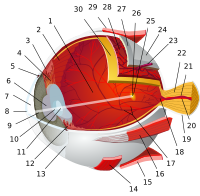Recurrent corneal erosion
Symptoms include recurring attacks of severe acute ocular pain, foreign-body sensation, photophobia (i.e. sensitivity to bright lights), and tearing often at the time of awakening or during sleep when the eyelids are rubbed or opened.
In other words, one may develop corneal erosions as a result of another disorder, such as epithelial basement membrane dystrophy (EBMD).
Optometrists and ophthalmologists have access to the slit lamp microscopes that allow for this more-thorough evaluation under the higher magnification.
These all essentially try to allow the surface epithelium to reestablish with normal binding to the underlying basement membrane, the method chosen depends upon the location and size of the erosion.
[citation needed] An option for minimally invasive and long-term effective therapy[9] is laser phototherapeutic keratectomy.
It is thought that the natural regrowth of cells in the following days are better able to attach to the basement membrane to prevent recurrence of the condition.
People with recalcitrant recurrent corneal erosions often show increased levels of matrix metalloproteinase (MMP) enzymes.
Treatment with oral tetracycline antibiotics (such as doxycycline or oxytetracycline) together with a topical corticosteroid (such as prednisolone), reduce MMP activity and may rapidly resolve and prevent further episodes in cases unresponsive to conventional therapies.
